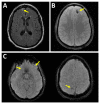Neuroimaging of Traumatic Brain Injury
- PMID: 30577545
- PMCID: PMC6358760
- DOI: 10.3390/medsci7010002
Neuroimaging of Traumatic Brain Injury
Abstract
The purpose of this article is to review conventional and advanced neuroimaging techniques performed in the setting of traumatic brain injury (TBI). The primary goal for the treatment of patients with suspected TBI is to prevent secondary injury. In the setting of a moderate to severe TBI, the most appropriate initial neuroimaging examination is a noncontrast head computed tomography (CT), which can reveal life-threatening injuries and direct emergent neurosurgical intervention. We will focus much of the article on advanced neuroimaging techniques including perfusion imaging and diffusion tensor imaging and discuss their potentials and challenges. We believe that advanced neuroimaging techniques may improve the accuracy of diagnosis of TBI and improve management of TBI.
Keywords: TBI; concussion; diffusion tensor imaging; perfusion imaging; traumatic brain injury.
Conflict of interest statement
The authors declare no conflicts of interest. The views expressed in this article are those of the authors and do not reflect the official policy or position of the US Government, the Department of Defense, or the Department of the Air Force.
Figures










References
-
- Marr A.L., Coronado V.G. Central Nervous System Injury Surveillance Data Submission Standards—2002. Centers for Disease Control and Prevention, National Center for Injury Prevention and Control; Atlanta, GA, USA: 2004.
-
- Faul M. Traumatic Brain Injury in the United States: Emergency Department Visits, Hospitalizations, and Deaths, 2002–2006. Volume vii. National Center for Injury Prevention and Control (USA); Atlanta, GA, USA: 2010. 70p
-
- Centers for Disease Control and Prevention Nonfatal traumatic brain injuries related to sports and recreation activities among persons aged ≤19 years-United States, 2001–2009. MMWR Morb. Mortal. Wkl. Rep. 2011;60:1337–1342. - PubMed
-
- Bass E., Golding H. The Veterans Health Administration’s Treatment of PTSD and Traumatic Brain Injury among Recent Combat Veterans. Volume ix. Congressional Budget Office; Washington, DC, USA: 2012. 39p

